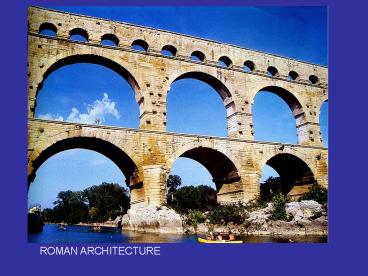ROMAN ARCHITECTURE - PowerPoint PPT Presentation
1 / 56
Title: ROMAN ARCHITECTURE
1
ROMAN ARCHITECTURE
2
(No Transcript)
3
Premises for Roman architecture The rise of
Rome as a single power in Italy, throughpolitical
subjugation of the other Italic groups, like the
Etruscans and Samnites. A complex intermingling
of sources - inheritances from the Etruscans, the
Greeks, but finally a clear Roman
version. Romes major character lay in its
military prowess and leadership. The advent of
the empire saw a highly organized system of
infrastructure and institutions. An aspect of
the empire was also its extravagance and
eccentricity, which showed in architectural
excesses. The centrality of the state in every
enterprise, including architecture. The monopoly
of the state/empire in everything including
resources and materials, as well as mobilizing
soldiers for construction projects.
4
Caesar
Romulus and Remus
Legendary foundation, 750 BCE Etruscan domination
until 500 Independent city republics, 509
BCE Military dictatorships Caesar,
Octavius Emperor Augustus Augustan Age Trajan
military extravagance and building
activities Hadrian peak of Roman
architecture Constantine shift of empire
5
Roman Empire, 31 BCE
6
(No Transcript)
7
Religion. Romans are a mixed people, and their
polytheistic religion was a fusion of several
cults, owing mostly to the Etruscans. In
contrast to the Greeks, the Etruscans involved a
more scrupulous attention to ritual, to
conformity, and to the will of the gods in a
fatalistic acceptance. These rules and rituals
required the priestly class in terms of mediation
in all aspects, however, in Roman culture, the
priests were nether powerful or privileged, but
only performed the sacrifices (unlike
India). But religion became part of the state
political system such that in imperial times, the
Emperor ultimately received divine honors, and in
many cases, became part of the pantheon of
deities. Ancestor worship was an important part
of religious rites. Every house, whether palace,
villa, or domus, had an altar to the Lares, or
the family gods, and for this reason Vesta, the
goddess of the hearth, was exalted to a high
position in the Roman pantheon, and vestal
virgins were of greater importance than the
priests.
8
Architectural Character. A combination of
Etruscan and Greek influences. The Romans
adopted the columnar and trabeate style of the
Greeks, and developed the arch and vault of the
Etruscans. This combined use of the column, beam
and arch is the keynote in early Roman
architecture. But soon the arch became the
emblem of Roman mind. By first century BCE, the
arch and vault is pervasive. Soon, the arch, and
its various forms - vault and dome - went on to
create a whole new architectural language. The
Orders of architecture which as used by the
Greeks were essentially constructive were
frequently employed by the Romans as decorative
features. Two Roman tendencies in planning
axial organization and complete enclosure or
inwardness. Examples atrium house and the
Forums. Predominant materials used stone,
marble, terracotta, brick, and a form of
concrete. But the material that led to
structural innovation was concrete, formed of
stone or brick rubble, and a mortar of which an
important ingredient was pozzolana, a volcanic
earth, found in thick strata in and around Rome
and Naples.
9
(No Transcript)
10
Building Types Temples Forums, center of public
life and commerce Baths (Thermae) Basilicas,
courtroom and assembly Theater Circus Colosseum/Am
phitheaters Arches Houses (domus) and Villas
11
City and temple building Funerary
mounds Templum/temenos
The Etruscans
12
Sanctuaries set at back Frontal emphasis Spacious
colonnade High podium Columns at front Projecting
eaves Three cellas
Etruscan Temple
13
A Corinthian temple to Jupiter. Frontality
emphasized. Front used as assembly. Raised
platform. Steps as in Etruscan temple.
Maison Carree, Nimes, 20 BCE
14
Raised on lofty podium Deep porch Engaged
columns Command assembly in front
Temple to Portunus, Rome, 2nd c. BCE
15
Maison Carree
16
Pantheon, a special sanctuary, dedicated to the
seven planets, a sort of astro-cosmological
machine.
17
The Pantheon, Rome, 118 CE
18
Interiorized/Introverted Centripetal Model of
cosmos Construction
19
Rotunda Oculus Coffered ceiling
20
(No Transcript)
21
Arch of Titus, Rome, c 81 CE
22
The Arch The Vault Voussoir
23
The Roman Forums Nature of civic
space. Completely enclosed space. Architecture of
connections and connectors. Organization of
space a space to space movement rather than an
object to object. Aided by the arch and vault
structure compare with agora and stoa
24
(No Transcript)
25
(No Transcript)
26
Trajans Forum, Rome
27
(No Transcript)
28
(No Transcript)
29
Forum Library
30
Vaulted ceiling Corinthian capitals
31
Basilica in Trajans Forum Inversion of Greek
temple
32
(No Transcript)
33
Basilica Plan axially organized and completely
inward. Two-storied gallery surrounded a central
open space. Use stock exchange with also
assembly and courtroom function. Possible
reference to stoa, now internalized and
enclosed or even a Greek temple where peristyle
now completely enclosed. An important building
type that will impact the formation of church
buildings.
34
Basilica of Maxentius and Constantine, Rome, 306
CE
35
Bath of Caracalla, Rome, 211 CE
36
(No Transcript)
37
Thermae Technology of water Hot air system under
floor Rooms with different heating
capacity Caldarium, tepidarium,
frigidarium Architecture of the spaces
38
(No Transcript)
39
Geometry, axis and architecture of connections
40
(No Transcript)
41
(No Transcript)
42
The Colosseum, Rome, 72 CE civic spectacles
43
(No Transcript)
44
(No Transcript)
45
(No Transcript)
46
(No Transcript)
47
(No Transcript)
48
Hadrians Villa
49
ROMAN HOUSE
Entrance Atrium Tablinum
Peristyle Garden
Impluvium
50
Atrium, House, Pompeii
51
Aquaducts
52
(No Transcript)
53
(No Transcript)
54
(No Transcript)
55
(No Transcript)
56
(No Transcript)

